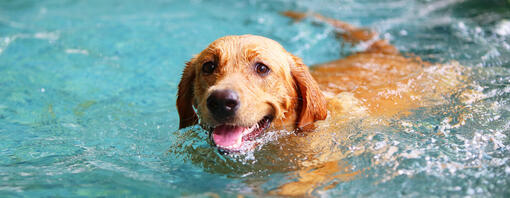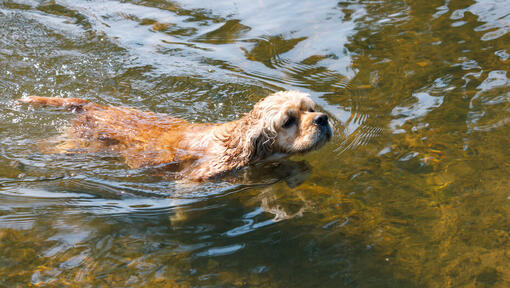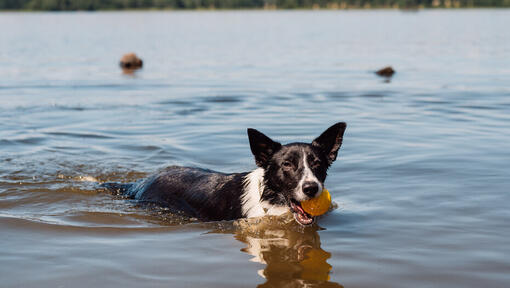
Can all dogs swim? While a lot of dogs have the ability to paddle in water, not all dogs can swim proficiently. There are, of course, dogs that take to the water like ducks and enjoy splashing around, but there also those who feel scared and do not know how to stay afloat.
But don’t worry – all dogs can learn to swim. In this article, we will explore how to teach your dog how to swim. It’s a simple process that may take some time, but if you do it properly you will have your dog paddling about in the water and eager to play in no time.
At what age should I teach a puppy to swim?
If you take a lot of hikes around lakes or spend time at the beach, you may want to start teaching your puppy to swim early. It is best to check with your vet on what age they recommend teaching your pup. This may depend on the breed and your dog’s personality, so it is best to get expert advice.
Don't worry if you have to wait a while before teaching your dog to swim. Use the time to make them comfortable with water. Fill your bathtub until it is a few inches deep with water and place your dog’s favourite toys in there.
Let them splash around and play; they will soon learn that there is nothing to fear!
Where do I teach my dog to swim?
There are a number of places recommended as teaching sites when considering how to teach your dog how to swim.
Small inflatable pools in your backyard may be best if you’re teaching a puppy. If you’re teaching a fully-grown dog, you would need a large pool. Make sure there are steps for your dog to enter the water gradually. Never throw your pup into the deep end and assume they will swim – it may scare them and put them off water.
It is possible to teach your dog how to swim in a bathtub, provided that there is enough space. If you have a small dog or a large bathtub, it may be the perfect environment.
Ponds or lakes are usually recommended sites for teaching your dog how to swim. Make sure the water deepens gradually and never leave your dog alone in the water, even for a moment. Always be prepared with safety equipment (see the information on safety first below).
Do not pick a natural body of water that has a strong current or powerful waves. This can be very dangerous and would scare your dog. Remember, if there are signs saying the lake isn’t safe for humans to swim, it also won’t be safe for your dog.
How to teach your dog how to swim
This step-by-step guide should soon have your dog swimming like a pro!
- Lead your dog gently into the water. Do not lead them too far in – make sure their paws and only part of their legs are wet. Allow them to splash around and get used to the feeling. This can take several such trips.
- Once they seem at ease, lead them deeper into the water. Make sure you are always right beside them and are holding them.
- Your dog’s first instinct will be to paddle with only their front legs. This is good but not that useful, as they will get tired very easily.
- Make sure your dog is all the way in the water and that you are holding them around the belly. The depth will mean that they start to kick with their back legs as well.
- Take the process as slowly as you need. If your dog looks scared or is anxious, stop, move back to the shore and give them some treats, praising them. Only go back into the water when they seem comfortable.
- The whole process may take some time so you need to be patient. Remember that your aim is show your dog that swimming is a fun and pleasant activity.
Safety first
An important part of teaching your dog how to swim is keeping their safety in mind. Never venture so far into the water that your feet cannot touch the ground. Your dog may try and use you as support during the lesson by climbing onto you. If you are swimming in deep water as well, this could push you under.
For extra security, you can use a flotation vest to support your dog. Make sure it fits your dog properly and put it on your pet before they enter the water. This way, they won't be doing all the work of staying afloat.
Swimming and dog breeds
While all dogs can swim, it is not an easy activity for all breeds. Bulldogs for instance have short legs which makes swimming harder and more tiring for them. They also do not have long necks, which makes putting their head out of the water difficult.
Labrador Retrievers, on the other hand, love water and will often jump into pools and swim with delight. For such breeds, swimming is an excellent exercise and a fun way for them to stay fit.
If your dog seems hesitant about entering the water, take time to make them comfortable. Motivation is also an important part of the teaching process. Come armed with treats and their favourite toys and praise them when they get their feet wet. Be mindful of when they look tired and stop the lesson accordingly.
You can use these actions to reinforce swimming as a pleasant activity. If you take the process slow and stay aware of their limitations, you’ll soon teach your dog that water is something to be loved and swimming is fun!
For more advice around training a dog and managing its behaviour check out our dog behaviour & training hub.








